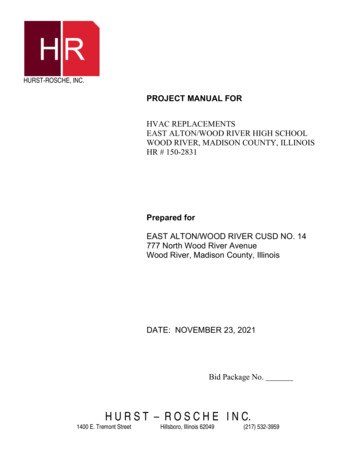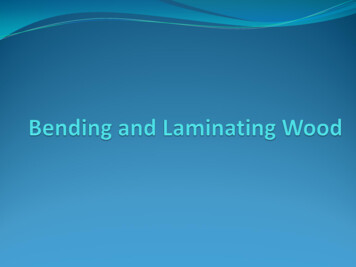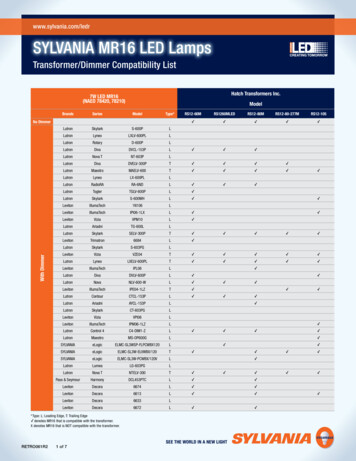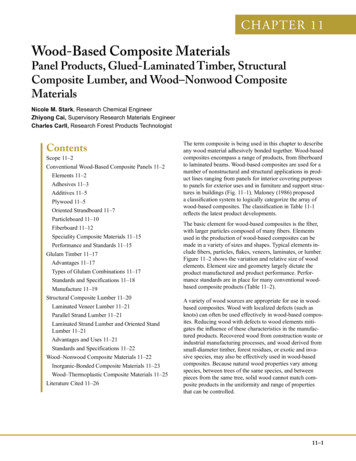
Transcription
2007:40DOCTORA L T H E S I SMicrowave Treatment of WoodLars HanssonLuleå University of TechnologyLTU SkellefteåDivision of Wood Physics2007:40 : -1544 : - -- 07 40 --
Microwave Treatment of WoodLars HanssonLuleå University of TechnologyDivision of Wood PhysicsSkellefteå CampusSkeria 3, SE-931 87 Skellefteå, Sweden
Microwave Treatment of WoodABSTRACTDrying wood using microwave energy is not very common, but could be acomplement to conventional air-circulation drying due to the possibility to drywood faster than the conventional drying methods with preserved quality.Furthermore, this technique could be used to condition boards with too highmoisture content gradient. In this study, an industrial-scale, online microwavedrier for wood components has been used and adapted to wood treatment. The aimof the present work was to investigate if the microwave drying method itselfaffects such wood properties as bending strength, hardness and colour change.Another aim was to explain, with finite element model simulations, the interactionbetween microwaves and wood during heating and drying and to a lesser extentalso during microwave scanning of wood. Tests of the mechanical properties ofwood showed no difference in bending strength in comparison with theconventional air circulation method. Nor was there any significant difference inwood hardness (Janka) perpendicular to the grain between the drying methods orbetween different temperature levels during the microwave drying. However, theresults showed that there is a significant difference in wood hardness parallel tothe grain between the methods when drying progressed to relatively lower levelsof moisture content; i.e. wood hardness becomes higher during microwave drying.The developed multiphysics finite element model is a powerful evaluation tool forunderstanding the interaction between wood and microwaves during heating anddrying as well as scanning. The model can be used for simulation of differentmicrowave treatments of wood.Keywords: Wood; FEM; Bending strength; Hardness; Matched samples;CT scanning; Microwave; Heating; Phase transition; Drying.i
Microwave Treatment of WoodPREFACEThis thesis was carried out at Luleå University of Technology, the Division ofWood Physics, Skellefteå Campus, under supervision of Dr. Lena Antti and Prof.Tom Morén.Freely translated, the Swedish poet Karin Boye says:”Yes, there is goal and meaning in our path- but it's the way that is the labour's worth.”The road to completing this thesis has been quite long and maybe a little bitwinding. But I would surely say that my knowledge is greater now than if the roadhad been straight. It has given me the opportunity to penetrate microwavetreatment of wood from different directions. Besides, I have had the privilege tocollaborate with competent people. First of all, Lena Antti, who deserves mywarmest thanks for her patient and excellent supervising. Many thanks also toNils Lundgren for the inspired collaboration and to Tom Morén for supervisingand for being a good adversary in our tennis games. I would also thank my othercolleagues at the Division of Wood Physics, especially Margot Sehlstedt-Persson,who has helped me to get an artistic touch to the figures and illustrations. In fact, Iowe many thanks to so many other employees at the Department in Skellefteå foruplifting discussions, conversations or just a good laugh. A special thanks to BrianReedy for the language reviewing of this thesis.Finally, I would like to express my sincere gratitude to my Elisabeth, who hasbeen a tremendous support all through this work.Skellefteå, 2007-10-31Lars Hanssonii
Microwave Treatment of WoodLIST OF PAPERSThis thesis is based on the work reported in following papers, referred to byRoman numerals:ǿHansson, L. & Antti, A.L. 2003. The effect of microwave drying onNorway spruce woods strength: a comparison with conventionaldrying. Journal of Materials Processing Technology, 141, pp 41-50.ǿǿHansson, L. & Antti, A.L. 2003. Design and performance of anindustrial microwave drier for on-line drying of wood components.The 8th International IUFRO Wood Drying Conference. 24-29 August,Brasov, Romania, pp 156-158.ǿǿIHansson, L. & Antti, A.L. 2005. The effect of drying method andtemperature level on the hardness of wood. Journal of MaterialsProcessing Technology, 171, pp 467-470.ǿVHansson, L., Lundgren, N., Antti A.L. & Hagman O. 2005.Microwave penetration in wood using imaging sensor. Journal ofInternational Measurement Confederation, 38(1), 15-20.VHansson, L., Lundgren, N., Antti A.L. & Hagman O. 2005. FEMsimulation of interactions between wood and microwaves. Journal ofWood Science, 52(5), 406-410.VILundgren, N., Hansson, L., Hagman O. & Antti A.L. 2006. FEMsimulation of interactions between microwaves and wood duringtawing. 2nd Conference on Mathematical Modelling of WavePhenomena. 14-19 August 2005, Växjö, Sweden. In: AIP ConferenceProceedings, 834, 260-267.VII Hansson, L., Lundgren, N., Antti A.L. & Hagman O. 2005. FEMsimulation of heating wood in an industrial microwave applicator. 10thInternational Conference on Microwave and High Frequency Heating.12-15 September, Modena, Italy.VIII Hansson, L. & Antti A.L. 2007. Modelling Heating and Drying ofWood. Submitted to Drying Technology, 31 May.iii
Microwave Treatment of WoodCONTRIBUTION TO THE INCLUDED PAPERSI – III and VIII: These works were written by the author withsupervision and comments by Lena Antti.IV – VII:These works were written by the author incollaboration with Nils Lundgren and withsupervision and comments by Lena Antti andOlle Hagman. In papers IV–VI the main partof collection and analysis of the microwavescanner data was done by Nils Lundgren.iv
Microwave Treatment of WoodCONTENTSABSTRACTPREFACEiiiLIST OF PAPERSCONTRIBUTION TO THE INCLUDED PAPERSiiiiv1 INTRODUCTION1.1 The objectives of this thesis1.2 Outline of the thesis2 THEORY2.1 Wood2.2 Electromagnetic waves2.3 Electromagnetic heating of wood2.4 Physical parameters used in the models2.5 Finite Element Method (FEM)2.6 Heat energy transfer between wood and the2.7surrounding environmentThe media flow in wood during heating and drying2.8 The microwave heating and drying equipment2.9 Change in wood material properties2.10 Colour response14466814172222232729313 CONCLUSIONS344 FUTURE WORK355 REFERENCES36APPENDIXErrata41
Microwave Treatment of Wood1 INTRODUCTIONFreshly sawn wood needs to be dried before making furniture, buildings, etc.,since a living tree has a dry-weight moisture content (mc) often exceeding 0.8,which means that the cell walls in this complex material are fully saturated andthe voids contain considerable amounts of free liquid water. Besides water, woodis composed of cellulose, lignin, hemicelluloses and a minor amount ofextractives. As long as human beings have used wood, man has attempted to dryit. In the beginning wood was probably only dried with the help of air and sun;during the last century there has been a constant development in artificial drying.The most common drying method nowadays is air-circulation drying. This dryingis based on heat conduction from the surface of the wood towards the interior forevaporation of moisture. Furthermore, the moisture moves to the surface by massflow in liquid and vapour phases. This mass flow is divided into three differentphases: capillary, transition and diffusion phase [1]. If the wood has an mc higherthan the fibre saturation point (fsp), the internal moisture reduction is a form offree water loss. The fsp is an imaginary point where all the free water is removedfrom the voids or vessels in the wood. Generally, the fsp is about 0.3. However, itvaries a little within each piece and with the wood temperature. During the dryingprocess, there are no significant dimensional changes as long as the mc exceedsthe fsp, but when bound water releases from the cell walls, dimensional changesstart to take place. These dimensional changes are not the same in all directions.Less common drying methods for industrial processing based on high-frequency(HF) electromagnetic fields are microwaves (MW), a combination of vacuum andMW [2] or radio frequency (RF) and vacuum [3, 4]. An RF drying system createsan alternating electric field between two electrodes. In order to avoid interferingwith radio communications, the Federal Communications Commission hasreserved radio frequencies at 13.56, 27.12 and 40.68 MHz for industrial use, withcorresponding wavelengths of about 22.1, 11.1 and 7.4 metres. With shorterwavelengths, the power penetration depth will decrease.1
Microwave Treatment of WoodCombining RF and vacuum for heating enables a lower boiling point withdecreasing pressure, which in turn means that the required drying temperature inorder to vaporize the water from the wood will decrease. Microwave and RFdrying techniques, in contrast to conventional drying, are based on the principlethat heat is instantly absorbed throughout the wet load. The microwave frequencyspectrum is approximately 0.3 GHz to 30 GHz with corresponding wavelengthsfrom one metre to one millimetre. The microwave spectrum is mainly used fortransmission and reception of information for communication purposes. However,certain regions called Industrial, Scientific and Medical (ISM) bands have beenallocated for microwave heating processes. The most commonly used frequenciesfor heating are 915 MHz and 2.45 GHz with wavelengths of approximately 33 and12 centimetres. A typical microwave heating system has two main components,the microwave source and the cavity. The most commonly used microwavegenerators are magnetrons. These microwave generators began to be used inindustrial microwave heating and drying equipment in the 1940s, and they werevery expensive. Nowadays magnetrons at 915 MHz and 2.45 GHz are relativelycheap, because they are used in domestic microwave ovens and are thereforemass-produced. The cavity is a metal box into which the microwaves are guidedand effectively reflected by the metallic walls. Furthermore, the waves resonateand will form standing waves. The position of the nodes and antinodes of thestanding waves in the cavity depends on the design of the cavity, i.e., itsdimensions. Also, the dielectric properties and the position of the load have someinfluence on the field distribution. The nodes and antinodes make the heatinguneven; i.e., hotter and colder spots will be developed in the material. Ifmicrowave heating technology is used for drying, then a consequence of thisuneven heating will be uneven drying, which in turn could cause drying stresses.The technology of microwave heating and drying in the field of forest productsstarted to be used in the early 1960s. At a frequency of 2.4 GHz, a drying rate of0.4 fractional mc per hour could be reached for boards of spruce and beech [5].2
Microwave Treatment of WoodWith a frequency of 915 MHz and a manipulated microwave input power and hotair, a 25-mm-thick pine plank could be dried in less than three hours [6] withoutdrying defects. A prototype continuous microwave dryer for softwood structurallumber could dry 50-mm-thick hemlock and Douglas fir in 5–10 hours with smalldrying defects [7]. Antti [8] has shown that it is possible to dry pine and spruce20–30 times faster than with conventional methods. For hardwoods such as beech,birch and ash, the drying time is approximately half the time required forsoftwood.The main problem in using this technique in wood drying is the uniform field. Inorder to reduce the problems of uneven field distribution and power intensity, anindustrial-scale online microwave drier for wood components has been adaptedfor wood at Luleå University of Technology, Division of Wood Physics [9, 10], toachieve a fairly uniform heating of the load in order to prevent stressdevelopment. Too high energy absorption may cause steam expansion checks.Oloyede and Groombridge [11] state that microwave heating could reduce thestrength of dried wood by as much as 60%. Furthermore, Machado [12] hasobtained a clear loss of compression strength parallel to the grain in microwaveexposed clear oak pieces. Torgovnikov and Vinden [13] use the steam expansioncaused by microwaves of high intensity to modify selected hardwoods byincreasing their permeability. After the modification, environmentally friendlyresin is infused throughout the wood, whereupon the wood is compressed,resulting in a wood-resin composite material.Microwave technology can also be applied to the scanning of wood, making itpossible to detect such wood properties as density and mc [14, 15]. The frequencyused in this microwave scanning project is 9.375 GHz.One way to understand and explain the physical processes in the interactionbetween wood and microwaves, which could be the basis for controlling andscheduling the heating, with or without drying, or for microwave scanning, is tomake simulation models [8, 16, 17, 18].3
Microwave Treatment of Wood1.1 The objectives of this thesisThere is a necessity to demonstrate the fact that microwave drying is acomplement and an adequate alternative to conventional drying methods as wellas to demonstrate its advantage in quality gains with the rapid heating and drying.The objectives of this thesis are to study whether the drying method itself affectssuch mechanical properties as bending strength and hardness. Raised temperaturein conventional drying gives rise to some changes in the wood characteristics,such as changes in colour. A brief study of colour response in microwave-driedwood is included in the thesis. Some of the results have been taken from studiesmade on a specially designed microwave drier for wood components. Hence, adescription of the specially designed microwave drier for wood components isincluded in this thesis. The objective of the thesis is also to develop an FEMmodel capable of explaining the interaction between microwaves and wood duringheating and drying and, to a lesser extent, also scanning.1.2 Outline of the thesisThis thesis contains, apart from a summary of the papers, a chapter describingrelevant features of wood as well as some theoretical explanations of microwavesand the interaction between microwaves and wood. Some further clarificationsand new information about the models and some of the studies that are notincluded in the papers are also included in this thesis. Almost all results are basedon the papers outlined in the schematic diagram, figure 1. In addition, figure 1depicts the relationships between the papers included in the thesis.4
Microwave Treatment of WoodPaper IThe effect of microwave drying on Norway spruce woodsstrength: a comparison with conventional drying.Paper IIDesign and performance of an industrial microwave drierfor on-line drying of wood components.Paper IIIThe effect of drying method and temperature level on thehardness of wood.Paper IVMicrowave penetration in wood using imaging sensor.Paper VFEM simulation of interactions between wood andmicrowaves.Paper VIFEM simulation of interactions between microwaves andwood during thawing.Paper VIIFEM Simulation of Heating Wood in an IndustrialMicrowave Applicator.Paper VIIIModelling Heating and Drying of Wood.Figure 1. Disposition of the papers included in the thesis.5
Microwave Treatment of Wood2 THEORY2.1 WoodWood is a complex material composed of cellulose, lignin, hemicellulose andminor amounts of extractives. The wood structure consists of a tissue of cells ofvarious shapes and sizes (figures 2 and 3) in which the elements are more or lesslinked together. These cells are arranged in radial files, and their longitudinalextension is oriented in the vertical direction or in the direction of the stem axis.Figure 2. Scanning Electron Microscope(SEM) photography of the cell structure ofbirch. Reprinted by permission of MargotSehlstedt-Persson.Figure 3. SEM photography of the cellstructure of Scots pine. Reprinted bypermission of Margot Sehlstedt-Persson.Most cells are aligned in the vertical axis, in softwood about 90% of the cells andin hardwood 80%-95%. These cells are known as tracheids in softwood, inhardwoods as tracheids, fibres and vessels [19]. A taper tube with close ends is theapproximate form of a tracheid, and the connections between them in the woodstructure are small holes or pits. The vessels, on the other hand, have the form ofcontinuous pipelines in an end-to-end arrangement. During the growing season,the wood structure develops differently at different times.6
Microwave Treatment of WoodIn the early period the tracheid walls become thin, and in the late period the wallsgrow thicker (figure 3). The remaining cells in the wood structure are rays, whichconsist of parenchyma cells. They are aligned perpendicular to the vertical axis.The functions of these various cell types are support and conduction for thevertically aligned cells and storage function for the cells situated perpendicularlyto the vertical axis.Figure 4. A cross-section of a stem. Reprinted by permission of Margot Sehlstedt-Persson.The layer (cambium) between the bark and pith can be divided into two differentkinds of functions for the wood (figure 4). The sapwood is located adjacent to thecambium and handles the transport of sap and water. Furthermore, heartwoodconsists, in contrast to sapwood, of inactive cells without functions in either waterconduction or sustenance storage. Many wood species form heartwood. In theregion where the sapwood makes the transition to heartwood, the extractivecontent is increased. Increased extractive content reduces permeability and makesthis part of wood more difficult to dry. However, the permeability of the wood,i.e., how large the wood voids are and how they are connected, has the maininfluence and sets a limit to the drying rate when microwave drying technology isused.7
Microwave Treatment of Wood2.2 Electromagnetic wavesAn electromagnetic wave has two components: an electric (E) and a magnetic (H)field. They oscillate perpendicular to each other (figure 5), and they areperpendicular to the direction of propagation.Figure 5. A monochromatic electromagnetic wave polarized in the y-z plane.A monochromatic electromagnetic wave is a sinusoidal wave of one singlefrequency and thus one single wave length (O). The direction of the electric fieldis described by the polarization. When the wave is horizontally polarized, theelectric field is horizontal, for example. The wave, which is moving in the ydirection, can be described mathematically [20] as a harmonic wave:E x, y , z , tE 0 e jZ Jy(1)H x, y , z , tH 0 e j Z Jy(2)where E0 and H0 are the amplitudes, or strengths, of the electric and magneticfields and oriented transverse to the y direction.8
Microwave Treatment of WoodFurthermore, Z is the angular frequency and J the complex distribution factordefined as:JjZ HPD jE ,(3)where P is the complex permeability. For wood, which is not a magnetic material,the complex permeability P is equal to the permeability of free space, P0.Furthermore, D is the attenuation factor, and E is the phase factor of the wave. H isthe relative complex permittivity defined as:HH 0 H c jH cc ,(4)where H0 is the absolute permittivity for vacuum, H is the relative permittivity andH is the relative dielectric loss factor. Relative permittivity indicates how muchslower the electromagnetic wave propagates in the material compared topropagation in vacuum. The relative dielectric loss factor includes all lossmechanisms that can arise in a dielectric material when an electromagnetic wavepenetrates or propagates through it. The loss is caused by frictional, inertial andelastic forces when the internal field in the material induces translational motionof bound or free charges, such as ions or electrons, and rotation of chargecomplexes, such as dipoles, e.g., water molecules. The relative dielectric lossfactor and the relative permittivity in wood have been thoroughly investigated[21]. These investigations have shown that the dielectric properties of wooddepend on mc, density, material temperature, frequency and the direction of theelectric field relative to the fibre direction.9
Microwave Treatment of WoodFigures 6 and 7 depict these dependencies in wood at a stated dry density. If thedensity increases or decreases, the value of relative permittivity and the dielectricloss factor will also increase or decrease. Figure 7 shows that at high mc thedielectric loss factor decreases as the temperature increases. This means that theenergy absorption decreases as the temperature increases.Figure 6. Relative permittivity as a functionof mc and temperature for a dry density of490 kg/m3.Figure 7. Dielectric loss factor as a functionof mc and temperature for a dry density of490 kg/m3.The relative permittivity and dielectric loss factor values used to form thediagrams in figures 6 and 7 are interpolated and collected from Torgovnikov’smeasurements [21], assumed to have a step transition as the water changes phasearound zero degrees Celsius.Combining equations 3 and 4 enables separation of the real and imaginary parts,and the expressions for the attenuation factor and phase factor will be:1D2§ c§·· 2H § H cc · Z H 0 P0 1 1 , 2 Hc ¹¹¹ and10(5)
Microwave Treatment of Wood1E2§ c§·· 2H § H cc · Z H 0 P0 1 1 . 2 Hc ¹¹¹ (6)Combining equation 3 with wave equation 1 shows that the wave amplitudeattenuates exponentially with the factor e-Dy and shifts phase with a factor I Ey,as the wave penetrates the wood material.e-DyyIFigure 8. An electromagnetic wave transmitted into wood (solid line) compared to a wavetransported in vacuum (dashed line).Figure 8 shows two electromagnetic waves, one in the form of a dashed line thatperceives wood as a transparent material and the other in the form of a solid linethat is influenced by the wood material properties. The disturbed wave isattenuated and makes a phase change relative to the undisturbed wave as it istransmitted through the wood material. A phase change is the displacementbetween reference points on each wave and is usually expressed in an angulardisplacement I (figure 8). The size of the phase shift and the attenuation dependon the mc and the dry density.11
Microwave Treatment of WoodThese parameters, attenuation and phase shift, are experimentally determined inthe wood scanning equipment in Papers IV, V and VI. These works give a betterunderstanding of how the microwaves are scattered and reflected by variations inthe wood. In addition, the wood scanning FEMs provide a good foundation for themicrowave heating models in Papers VII and VIII.When the electromagnetic field oscillates, the polarity will change according tothe frequency. Furthermore, the polar molecules in the wood try to oscillate inphase with these changes. However, as described earlier, these induced motionswill be slowed down by frictional, inertial and elastic forces, causing theproduction of heat in the material. The heating, which occurs by microwaves, is aconversion of the electromagnetic energy into heat. The law of conservation ofenergy states that the total amount of energy in an isolated system remainsconstant. However, it may change form. For example, friction turns kinetic energyinto thermal energy. Conservation of the electromagnetic field’s energy is statedby the Poynting theorem [22]. From this theorem, the average total absorbedpower can be expressed as:Pav2ZH 0 H ccE rmsV,(7)where E2rms is the root mean square of the effective electric field and V is thevolume.When the transmitted power decays to 1/e of its original value from the surface ofthe material, the power penetration depth [22] is defined as:Dp1.2D12(8)
Microwave Treatment of WoodThe penetration depth is affected by the dielectric properties of wood. Higherdensities and moisture contents result in decreased power penetration depth, asshown in figure 9. The temperature has a minor effect on the power penetrationdepth, apart from the step transition at zero degrees (figure 10). Microwaveenergy penetrates far deeper into frozen wood than into wood at roomtemperature.Figure 9. Power penetration depth as a function of mc for different dry wood densities at roomtemperature at a frequency of 2.45 GHz.Figure 10. Power penetration depth as a function of mc in wood at different temperatures, drydensity 490 kg/m3 and frequency 2.45 GHz.13
Microwave Treatment of Wood2.3 Electromagnetic heating of woodThere are various methods that can be applied for heating a material. Inconvective heating, heat is transferred to the material surface by a circulatingfluid. In radiation, heat is transferred to the material surface by radiation. Inconductive heating, heat is transferred to the material surface through connectionto another material surface with higher temperature. In internal heating, only thematerial will be heated, compared to conventional heating where the surroundingarea takes part in the transfer of energy or heat. The material heats instantly in theinterior regions, making heating faster than with convectional heating.Wood with a high mc, above the fibre saturation point, is capable of absorbing agreat amount of electromagnetic energy. The amount of energy required to raisethe temperature is determined by the specific heat capacity value of the material.Low values require less electromagnetic energy to increase the temperature. Thespecific heat capacity for wood is influenced by the mc, dry density and thetemperature [23, 24, 25, 26]. The higher the mc, dry density and temperature, thehigher becomes the specific heat. Furthermore, the specific heat for wood has aphase transition at zero degrees C, since it contains water. The higher the mc is,the higher is this change, which is obvious, since water has this quality at zerodegrees Celsius. When the water changes phase, from solid (ice) to liquid or fromliquid to gas (vapour), the energy alters the water structure and a certain amountof heat is transmitted to the water instead of increasing the temperature. Thisrequired amount of energy to change phase from solid to liquid is called heat offusion; from liquid to vapour it is called heat of vaporization.To implement this quality of behaviour in a physical model, a normalized pulsearound the temperature transitions can be used (figure 11). This will avoid theconvergence problem in the simulation caused by the sharp change in the thermalproperties when the temperature varies.14
Microwave Treatment of WoodA normalized pulse is equal to unity in a specified interval, in this case at thetemperature intervals where the phase transitions from ice to water and from waterto vapour occur.Figure 11. Normalized pulses around the temperature transitions.The narrower this pulse is, the more it resembles a phase shift. However, itrequires considerable computational power to integrate this phase transition intophysical models.When wood absorbs microwave energy, the total volume will be instantly heatedif the wood volume and the MW frequency are adjusted to each other. However,the heating will not be uniform throughout the volume due to the nature of MWand the varying material properties. Heat conduction will serve to level out theuneven temperature distribution. The thermal conductivity of wood is dependenton mc, dry density, temperature and fibre direction [23, 25, 26]. The higher themc, dry-weight density and temperature, the higher the thermal conductivity.Furthermore, the conductivity in the direction of the grain is higher than across thegrain. The temperature variation in a given region in the wood over time can bedescribed physically in a transient energy-balance equation. This heat equationdescribes the heat transfer by conduction and convection.15
Microwave Treatment of WoodIn the 2-D models that were developed, internal heat transfer by convection isomitted because of the small influence on the solution and because the omissionmakes the model less complex to solve. The energy-balance heating equation hasthe form:UCwT k T Qwt0,(9)where T is the temperature, ȡ is wet wood density, t is time, C is the specific heatcapacity, k is the thermal conductivity of wood and Q is the external heat source.The specific heat capacity is a function of the specific heat capacity of water andwood. In Paper VI, in which microwave scanning is described, the heat term, i.e.,the microwave energy, is zero, since the electric field is very low duringmicrowave scanning. However, in Paper VII and VIII, in which wood heating ismodelled, the external heat source is the resistive heat generated by theelectromagnetic field and is defined as:Q 12Re V E jZ ED2@,(10)where V is the conductivity, E is the electric field and D* is the conjugate of theelectric displacement.16
Microwave Treatment of Wood2.4 Physical parameters used in the modelsTo determine physical parameters as dielectric properties, heat conduction, heatcapacity, void volume, mc and wet and dry wood densities need to be known. Byusing a computed tomography (CT) scanner (Siemens Somatom AR.T.), wet anddry wood densities can be experimentally measured. A CT scanner works, insimple terms, such that several beams of X rays are sent from different anglesthrough the scanning object, and after transmission, they are detected and theirstrength measured. Beams that have passed through less dense parts, such as forexample dry sapwood, will be stronger, whereas beams that have passed throughdenser parts, such as for example wet sapwood, will be weaker. This informationwill be computer processed, resulting in a cross-section image of 512 x 512 pixelsin which the densities of the object are shown in the form of grey-scales. If theshape of the area profile is the same for the wet and dry density images, it wouldbe possible to calculate the mc from the CT images directly by subtracting theimages. Since wood starts to shrink
drier for wood components has been used and adapted to wood treatment. The aim of the present work was to investigate if the microwave drying method itself affects such wood properties as bending strength, hardness and colour change. Another aim was to explai










